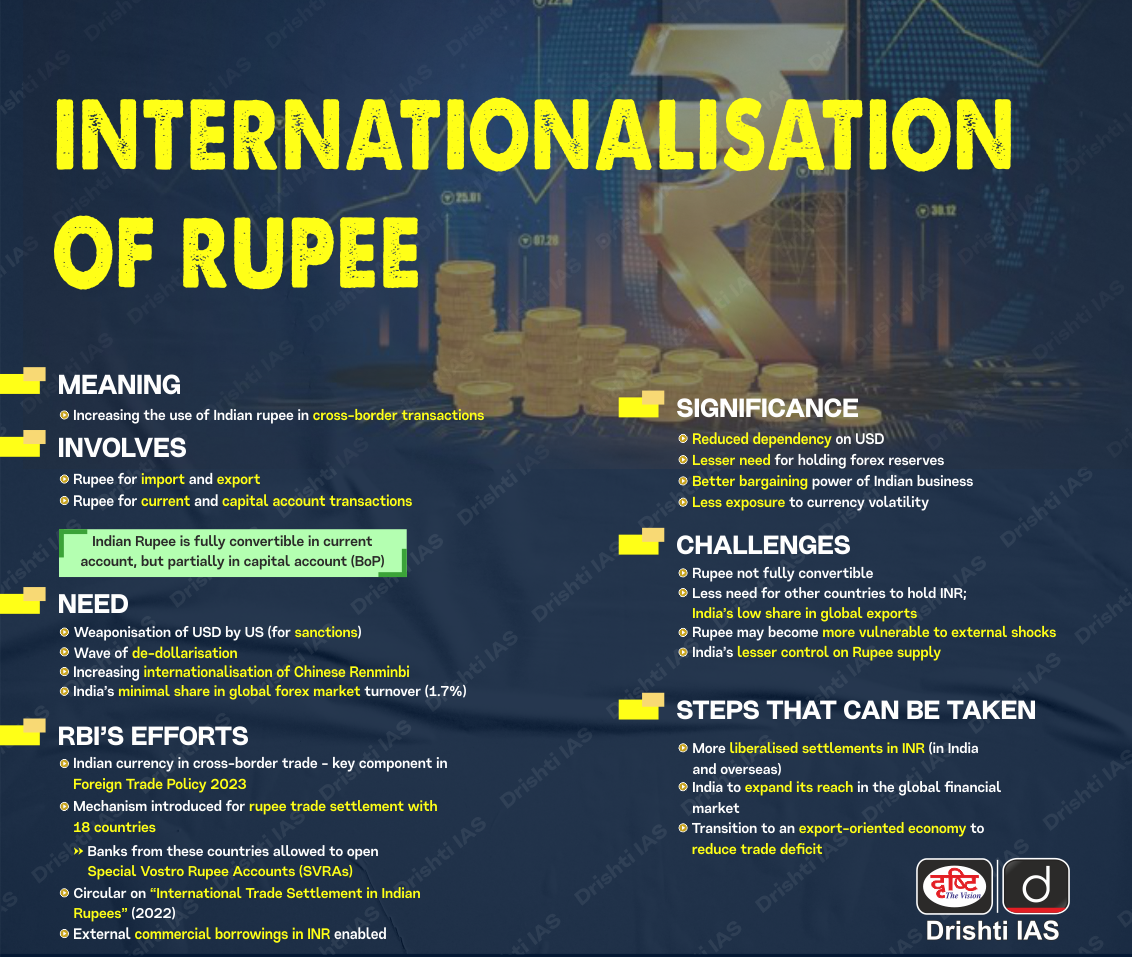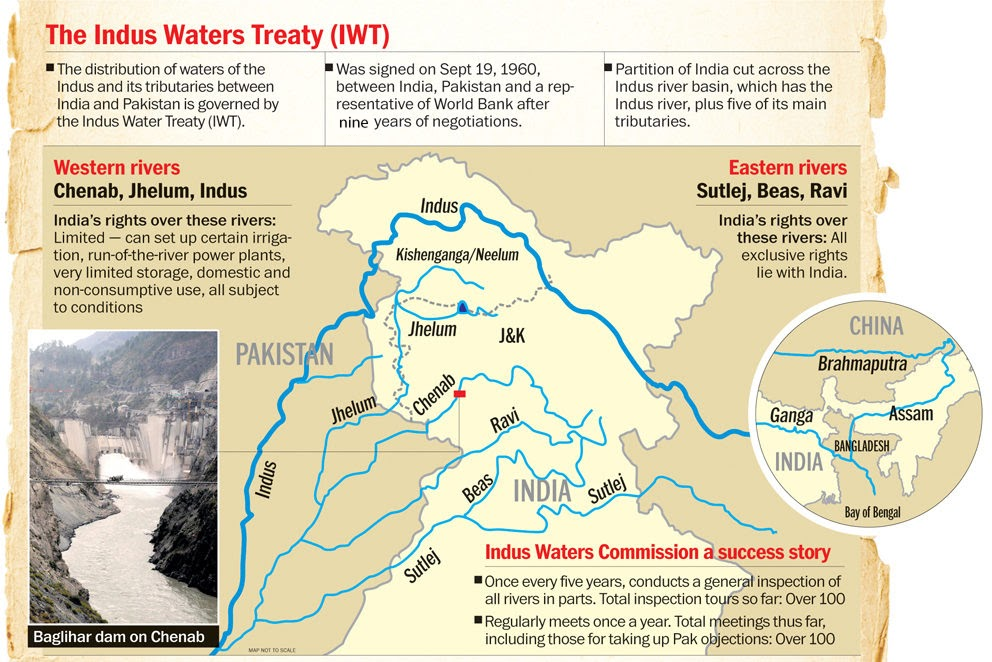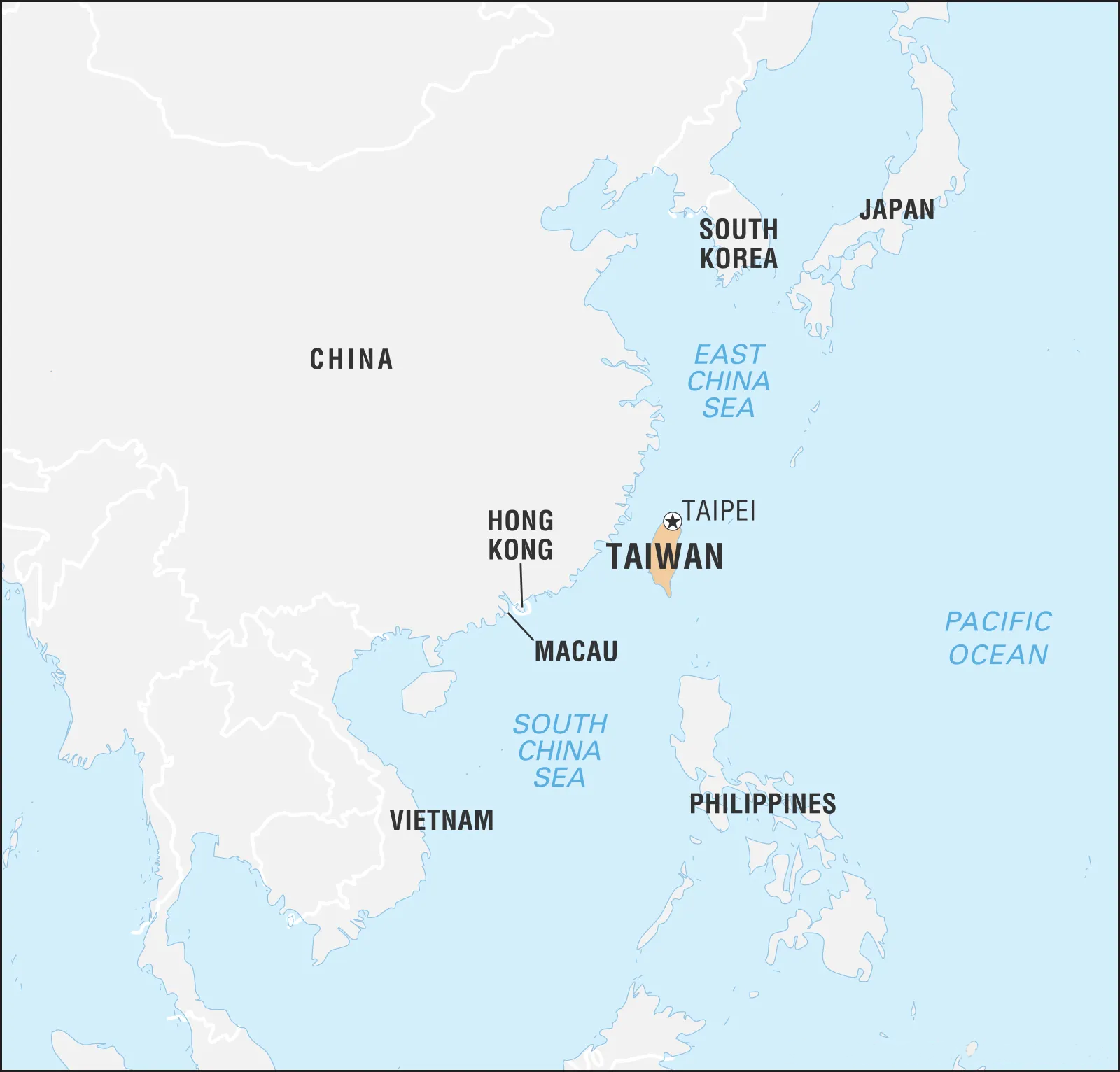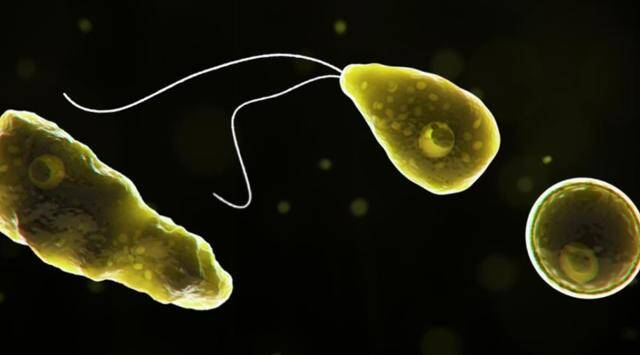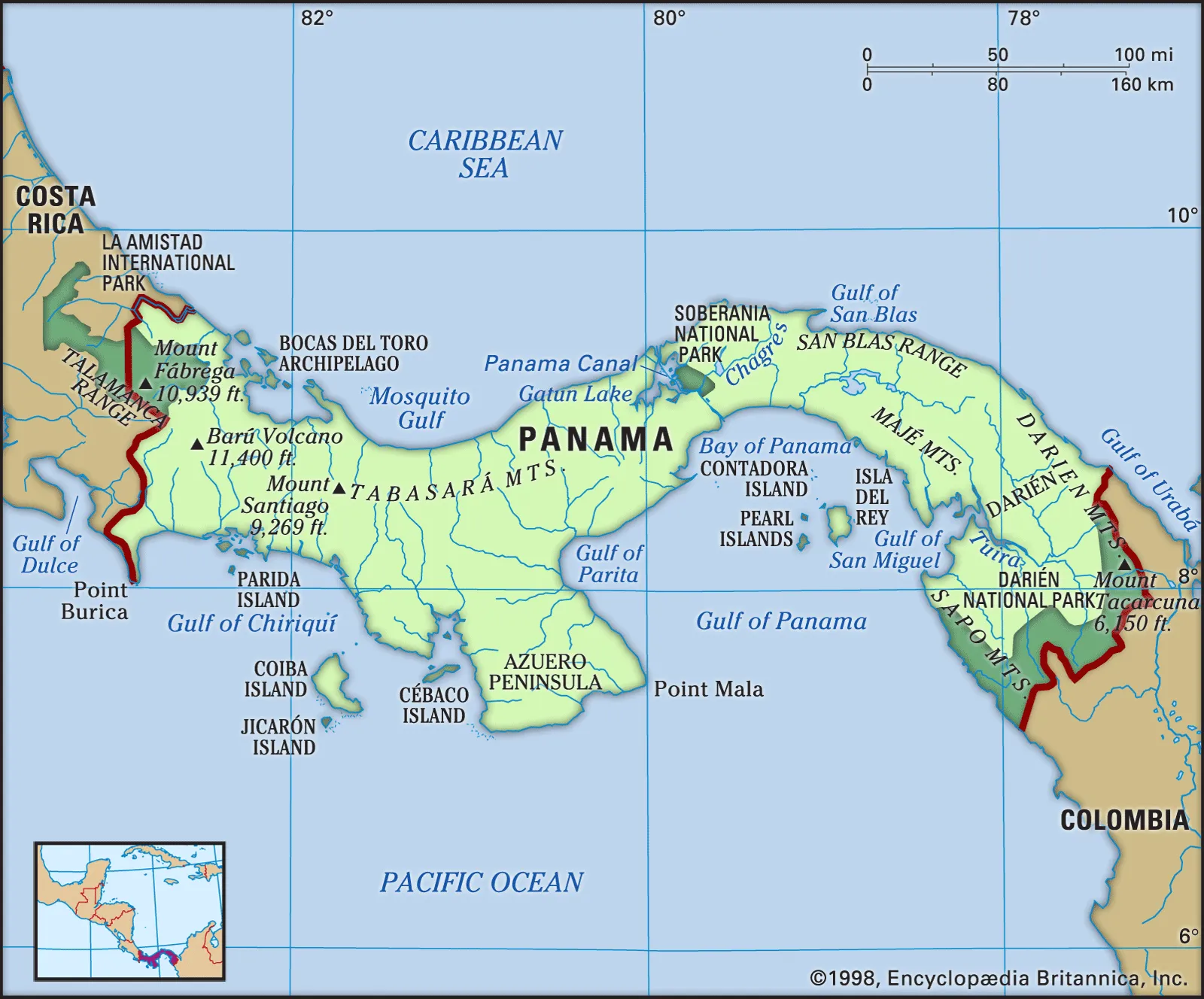Infographics
Internal Security
PCA Asserts Competence in India-Pakistan Hydroelectric Projects Dispute
For Prelims: Court of Arbitration, Indus Waters Treaty, Permanent Court of Arbitration (PCA), World Bank
For Mains: Indus Waters Treaty and associated implementation issues.
Why in News?
The Hague-based Permanent Court of Arbitration (PCA) recently ruled that it has the competence to hear Pakistan's objections to India's Kishenganga and Ratle hydroelectric projects in Jammu and Kashmir.
- India, however, rejects the constitution of the "Court of Arbitration," asserting that it goes against the provisions of the Indus Waters Treaty(IWT).
What is Indus Waters Treaty?
- About:
- The Indus Waters Treaty is a water-sharing agreement between India and Pakistan.
- The treaty was brokered by the World Bank and signed on September 19, 1960.
- It governs the distribution and utilization of the waters of the Indus River system, which includes six rivers: Indus, Jhelum, Chenab, Ravi, Beas, and Sutlej.
- The treaty aims to promote cooperation and peaceful management of transboundary water resources between India and Pakistan.
- Allocation of Rivers:
- Under the treaty, three eastern rivers (Ravi, Beas, and Sutlej) are allocated to India for unrestricted use.
- The three western rivers (Indus, Jhelum, and Chenab) are allocated to Pakistan for unrestricted use.
- India is allowed limited use of the western rivers for domestic, non-consumptive, and agricultural purposes.
- Key Provisions:
- Construction of Projects:
- The treaty permits India to construct run-of-the-river hydroelectric projects on the western rivers, subject to certain conditions.
- Dispute Resolution:
- Communication via Permanent Indus Commission (PIC):
- PIC has a commissioner from each country.
- Parties inform each other about planned projects on the Indus River.
- PIC facilitates the exchange of necessary information.
- Aimed at resolving differences and avoiding escalation.
- Neutral Expert:
- If the PIC fails to resolve the issue, it advances to the next level.
- The World Bank appoints a neutral expert.
- Expert attempts to resolve differences.
- Court of Arbitration (CoA):
- If a neutral expert fails, the dispute goes to CoA.
- CoA resolves the dispute through arbitration.
- The IWT states that Neutral Expert and CoA steps are mutually exclusive, meaning that only one of them can be used at a time for a given dispute.
- Communication via Permanent Indus Commission (PIC):
- Construction of Projects:
What is the Hydroelectric Project Dispute Between India and Pakistan?
- Hydroelectric Projects:
- The case involves a dispute between India and Pakistan over the Kishenganga hydroelectric project (on the Kishanganga River, a tributary of the Jhelum River), and the Ratle hydroelectric project (on the Chenab River) in Jammu and Kashmir.
- The two countries disagree over whether the technical design features of these two hydroelectric plants contravene the IWT.
- The case involves a dispute between India and Pakistan over the Kishenganga hydroelectric project (on the Kishanganga River, a tributary of the Jhelum River), and the Ratle hydroelectric project (on the Chenab River) in Jammu and Kashmir.
- Pakistan's Objections:
- Pakistan objects to the hydroelectric projects, citing violations of the IWT, concerns about reduced water flow, environmental impact, and differing treaty interpretations.
- In 2016, Pakistan retracted its request for a Neutral Expert and proposed a CoA instead.
- India requested the appointment of a Neutral Expert in 2016, emphasizing its importance in the process, which Pakistan sought to bypass.
- World Bank Intervention:
- World Bank paused the process due to separate requests from India and Pakistan, urging resolution through the PIC.
- Pakistan refused to discuss the issue during PIC meetings, leading the World Bank to initiate actions on Neutral Expert and Court of Arbitration.
- The Treaty does not empower the World Bank to decide whether one procedure should take precedence over the other.
- The World Bank sought to fulfill its procedural obligations with respect to both the CoA and the Neutral Expert.
- India's Opposition:
- India opposes the constitution of the CoA, citing contravention of Indus Waters Treaty provisions.
- India also questioned the jurisdiction and competence of the CoA, stating that it was not properly constituted as per the treaty.
- India has not appointed arbitrators or attended the court's proceedings, emphasizing the need for a single dispute resolution process.
What is the Ruling of the Permanent Court of Arbitration?
- Ruling:
- The PCA ruled that the Court of Arbitration (CoA) has the competence to consider Pakistan's objections to India's hydroelectric projects in Jammu and Kashmir.
- The ruling was based on a unanimous decision, binding on both parties and without any possibility of appeal.
- The PCA rejected India's objections to the competence of the CoA, as raised through its communications with the World Bank.
- India's Response:
- India has been maintaining that it will not join the Pakistan-initiated proceedings at the PCA as the dispute is being already examined by a neutral expert under the framework of the IWT.
- Implications:
- The PCA's ruling adds complexity and uncertainty to the ongoing dispute between India and Pakistan regarding the hydroelectric projects.
- The ruling challenges India's position and raises questions about the effectiveness and interpretation of the IWT.
- The implications of the ruling extend beyond the specific dispute, potentially impacting bilateral relations between India and Pakistan, particularly concerning water-sharing and cooperation.
What is Permanent Court of Arbitration?
- It was established in 1899 and is headquartered in The Hague, Netherlands.
- Purpose: It is an intergovernmental organization dedicated to serve the international community in the field of dispute resolution and to facilitate arbitration and other forms of dispute resolution between States.
- It has a three-part organizational structure consisting of:
- Administrative Council - to oversee its policies and budgets,
- Members of the Court - a panel of independent potential arbitrators, and
- International Bureau - its Secretariat, headed by the Secretary-General.
- Funds: It has a Financial Assistance Fund which aims at helping developing countries meet part of the costs involved in international arbitration or other means of dispute settlement offered by the PCA.
UPSC Civil Services Examination Previous Year Question (PYQ)
Prelims
Q1. With reference to the Indus river system, of the following four rivers, three of them pour into one of them which joins the Indus directly. Among the following, which one is such a river that joins the Indus direct? (2021)
(a) Chenab
(b) Jhelum
(c) Ravi
(d) Sutlej
Ans: (d)
Exp:
- The Jhelum joins the Chenab near Jhang in Pakistan. The Ravi joins the Chenab near Sarai Sidhu.
- Satluj is joined by the Chenab in Pakistan. Thus, Satluj receives the collective drainage of the Ravi, Chenab, and Jhelum rivers. It joins the Indus a few kilometers above Mithankot.
- Therefore, option (d) is the correct answer.
Mains
Q. Present an account of the Indus Water Treaty and examine its ecological, economic and political implications in the context of changing bilateral relations. (2016)
Governance
Performance Grading Index for Districts and PGI 2.0
For Prelims: Performance Grading Index for Districts, Unified District Information System for Education Plus, NAS, Daksha and Utkarsh, NEP 2020.
For Mains: Performance Grading Index for Districts.
Why in News?
Recently, the Ministry of Education (MoE), Government of India has released the Performance Grading Index for Districts (PGI-D) combined report for 2020-21 & 2021-22, assessing the performance of the school education system at the District level.
- The MoE has also released a report on Performance Grading Index (PGI) 2.0 for States/UTs for the year 2021-22.
What is the Performance Grading Index for Districts (PGI-D)?
- About:
- PGI-D assesses the performance of the school education system at the district level by creating an index for comprehensive analysis.
- The PGI-D assessed district-level performance in school education based on the data collected from various sources, including Unified District Information System for Education Plus (UDISE +), National Achievement Survey (NAS), 2017 and data provided by respective districts.
- Since 2017-18, MoE has released five annual reports that provide insights on status of school education in States and UTs.
- Grades:
- The report has 10 grades under which districts are categorized,
- Daksh: Highest grade (above 90%)
- Utkarsh: 81%-90%
- Ati-Uttam: 71%-80%
- Uttam: 61%-70%
- Prachesta-1: 51%-60%
- Prachesta-2: 41%-50%
- Prachesta-3: 31%-40%
- Akanshi-1: 21% to 30%
- Akanshi-2: 11% to 20%
- Akanshi-3: Lowest (less than 10%)
- The report has 10 grades under which districts are categorized,
- Indicators:
- The PGI-D structure comprises total weight age of 600 points across 83 indicators, which are grouped under 6 categories viz., Outcomes, Effective Classroom Transaction, Infrastructure Facilities & Student’s Entitlements, School Safety & Child Protection, Digital Learning and Governance Process.
- Significance:
- The PGI-D report is expected to assist state education departments in identifying gaps at the district level and improving performance in a decentralized manner.
- By prioritizing areas for intervention, districts can work towards reaching the highest grade and enhancing overall education quality.
What are the Key Highlights of the Report?
- Impact of the Pandemic on District Performance:
- None of the districts were able to achieve the top two grades (Daksh and Utkarsh).
- The number of districts categorized as Ati-Uttam decreased significantly from 121 in 2020-21 to 51 in 2021-22, indicating the impact of the pandemic on educational performance.
- Several districts across different states were categorized as Ati-Uttam in both 2020-21 and 2021-22, including Krishna and Guntur in Andhra Pradesh, Chandigarh, Dadra Nagar Haveli, districts in Delhi, Karnataka, Kerala, Odisha etc.
- Changes in Grades:
- In 2021-22, the number of districts categorized as Prachesta-2 (sixth-highest grade) increased from 86 in 2020-21 to 117.
- It suggests that more districts faced challenges in maintaining their performance due to the disruptions caused by the pandemic.
What is PGI 2.O?
- About PGI: The PGI is a comprehensive assessment tool devised by the MoE for evaluating the performance of the school education system at the State/UT level.
- It assesses the performance based on various indicators and creates an index for comprehensive analysis.
- The PGI was first released for the year 2017-18 and has been updated up to the year 2020-21.
- Revised Structure: The PGI was revised for the year 2021-22 and renamed as PGI 2.0. The new structure includes 73 indicators grouped into two categories:
- Outcomes and Governance Management (GM). Emphasis is given to qualitative assessment, digital initiatives, and teacher education.
- Categories and Domains: The PGI 2.0 is divided into six domains:
- Learning Outcomes (LO), Access (A), Infrastructure and Facilities (IF), Equity (E), Governance Process (GP), and Teachers’ Education and Training (TE&T). These domains cover various aspects of the education system.
- Grading System: States and Union Territories are assigned grades based on their points scored across the indicators.
- The grades range from Daksh (941-1000) as the highest to Akanshi-3 (401-460) as the lowest.
- Findings:
- None of the States/UTs achieved the top grades in the latest edition.
- Only two states/UTs, namely Punjab and Chandigarh have attained Grade Prachesta -2 (score 641-700).
- Andhra Pradesh has secured Grade 8 (Category: Akankshi-1) in PGI 2.0.
- Andhra Pradesh has made significant progress in its grades over the years, starting from no grade in 2017-18 to attaining Level II with a score of 901.
What are the Government Initiatives Related to School Education?
Indian Polity
Protecting the Honour of National Anthem
For Prelims: Article 51 (A), History and evolution of national anthem, Prevention of Insults to National Honour Act 1971
For Mains: Prevention of National Symbols, Honour of National Anthem and Supreme Court’s Judgements
Why in News?
Recently the Executive Magistrate in Srinagar sent 11 men to jail after detaining them for allegedly not rising for the National Anthem at an event where J&K Lt Governor was present.
- The order noted that “there is every likelihood that they may commit breach of peace and disturb public tranquillity if released”.
- They were “bound down” for good behaviour under sections 107/151 of CrPC.
Note:
- In legal terms, to be “bound down” means to be required to appear before the investigating officer or the court on a given date.
- The accused is bound by surety or personal guarantee to appear before the court.
Who is an Executive Magistrate?
- The CrPC classifies magistrates into 2 types - Executive Magistrates and Judicial Magistrates. Section 3(4) of the CrPC enforces on good relations between the two.
- An Executive Magistrate (EM) is an officer (or officers) of the Executive branch who has powers under both Indian Penal Code (IPC) and Criminal Procedure Code (CrPC).
- The EMs are appointed by state governments, and they focus mainly on maintaining law & order and performing police and administrative functions.
- On the other hand, Judicial Magistrates give verdicts pronouncing punishments/ penalty/ detention and go through the evidence in the process of investigation.
- Also, the Judicial Magistrates are under direct control of High Courts.
- EMs sometimes act as courts when they take up functions that are judicial in nature while conducting an inquiry (CrPC Sec.116) in connection with maintaining peace and order (CrPC Sec.107).
What are Section 107 and Section 151 of CrPC?
- Section 107: When an EM receives information that any person has disturbed (or is likely to disturb) the peace or public tranquillity, s/he may ask such person to show cause why they should not be ordered to execute a bond for keeping the peace (maximum period one year).
- Any EM can take such an action provided either one (if not both) falls in his/her jurisdiction:
- The place where such breach of peace is likely to occur
- The person who is likely to disturb the peace
- Any EM can take such an action provided either one (if not both) falls in his/her jurisdiction:
- Section 151: It provides for the arrest to prevent the commission of cognisable offences.
- It authorises a police officer who comes to know of some persons planning to commit any such offences, to arrest them without a warrant or Magistrate orders.
- However, they cannot be held in custody for more than 24 hours unless further orders (or any other law) provide so.
What is the National Anthem of India?
- About:
- It is one of the national symbols of India, composed by Rabindranath Tagore. The anthem highlights India’s national heritage and demonstrates patriotism and loyalty to the country.
- Origin:
- On December 27, 1911, Tagore performed the anthem for the first time in an INC session in Calcutta.
- It was again performed in 1941 by Subhash Chandra Bose but he adopted a slightly different version from the original song, called ‘Shubh Sukh Chain’.
- Evolution and Adoption:
- Tagore wrote the first anthem in Bengali ‘Bharoto Bhagyo Bidhata’ which later was edited and translated as ‘Jana Gana Mana’.
- It was adopted as the national anthem on January 24, 1950, announced by the then President Dr Rajendra Prasad.
What are the Safeguards to Protect the Honour of the National Anthem?
- Article 51 (A):
- It is part of the Fundamental duties of the citizens of India.
- Every Indian citizen has a responsibility to uphold the Constitution's values and institutions, as well as the National Flag and the National Anthem.
- Prevention of Insults to National Honour (PINH) Act, 1971:
- The Act stated that strict punishment will be meted out for disrespecting the national anthem and breaking its restrictions.
- The accused shall be punished with imprisonment for up to 3 years or a fine or both.
- National Anthem Code of Conduct:
- It provides that whenever the Anthem is sung or played, the audience shall stand to attention.
- However, when in the course of a newsreel or documentary the Anthem is played as a part of the film, it is not expected of the audience to stand.
- It also lists the occasions where the short or full versions of the National Anthem will be played.
- It provides that whenever the Anthem is sung or played, the audience shall stand to attention.
What are the SC’s Views Regarding Honour of the National Anthem?
- Bijoe Emmanuel & Ors vs State of Kerala & Ors. (1986):
- The law around alleged disrespect to the National Anthem was laid down by the Supreme Court (SC) in this case.
- The SC granted protection to 3 children belonging a Christian sect, iterating that forcing them to sing the national anthem was violative of their fundamental right to freedom of religion (Article 25).
- Their parents pleaded before Kerala HC that the Jehovah’s Witnesses sect of Christianity permitted worship of only Jehovah (Hebrew name for God). Since the anthem is a prayer, they could stand up in respect, but could not sing.
- The SC held that standing up respectfully but not singing oneself neither prevents the singing of the National Anthem nor causes disturbance to people assembled to sing. Hence, it does not constitute an offence under PINH Act 1971.
- Shyam Narayan Chouksey vs Union of India (2018):
- While hearing the same case in 2016, the SC had passed an interim order mandating all the Indian cinema halls to play the National Anthem before the beginning of the film and all those present in the hall are obliged to stand up.
- However, in its final judgement on the case in Jan 2018, the SC modified its order - “Playing of the National Anthem prior to the screening of feature films in cinema halls is not mandatory, but optional or directory”.
UPSC Civil Services Examination Previous Year Question (PYQ)
Q. With reference to Madanapalle of Andhra Pradesh, which one of the following statements is correct? (2021)
(a) Pingali Venkayya designed the tricolour Indian National Flag here.
(b) Pattabhi Sitaramaiah led the Quit India Movement of Andhra region from here.
(c) Rabindranath Tagore translated the National Anthem from Bengali to English here.
(d) Madame Blavatsky and Colonel Olcott set up headquarters of Theosophical Society first here.
Ans: (c)
Biodiversity & Environment
Impact of Microplastics on Gut Microbiomes
For Prelims: Impact of Microplastics on Gut Microbiomes, FAO, Microplastics, Dysbiosis.
For Mains: Impact of Microplastics on Human Health and Environment.
Why in News?
Recently, the FAO (Food and Agriculture Organization) in its report “Impact of Microplastics and Nanoplastics on Human Health” highlighted that the Microplastics and nano plastics considerably impact human and animal gut microbiomes as well as the environment.
What is Gut Microbiome?
- The gut microbiome is the totality of microorganisms, bacteria, viruses, protozoa, and fungi, and their collective genetic material present in the gastrointestinal tract (GIT).
- The gut microbiota plays an important role in nutrient and mineral absorption, synthesis of enzymes, vitamins and amino acids, and production of short-chain fatty acids (SCFAs).
- The microbiome refers to the collection of genomes from all the microorganisms in the environment while Microbiota usually refers to microorganisms that are found within a specific environment.
What are the Key Highlights of the Report?
- Intestinal Inflammation and Dysbiosis:
- Exposure to plastic has led to intestinal inflammation and gut dysbiosis — changes in the gut microbiome and microbiota.
- Microplastics act as stressors and cause inflammatory responses in the host, affecting certain microorganisms and resulting in microbial dysbiosis.
- Dysbiosis is defined by an imbalance in bacterial composition, changes in bacterial metabolic activities, or changes in bacterial distribution within the gut.
- Deposition in Human Body:
- Microplastics found in water bottles and food items such as sugar, honey, sea salt, tea and others have eventually deposited in human lung tissue, placenta, stool, blood and meconium.
- Plastics' Interaction with the Environment:
- Plastics of hydrophobic nature can adsorb hydrophobic chemicals or persistent organic pollutants from the environment (for example, polychlorinated biphenyls, polycyclic aromatic hydrocarbons and dichloro diphenyl trichloroethane).
- Impact on Organism and Metabolism:
- Accumulation of microplastic in the gut, changes in the mucus layer and gut permeability, alterations of the mucosal structure, oxidative stress and immune response.
- Physical abrasion of microplastic and its accumulation in the gut can lead to satiety in the organism and even reduce food consumption.
- It may eventually lead to weight loss and metabolic changes and can also affect liver function and metabolism.
- The severity of the impact is proportional to the concentration and particle shape of microplastics.
What is the Significance of the Findings?
- The FAO report emphasizes the significant impact of microplastics and nanoplastics on gut microbiomes and human health.
- Understanding the effects of plastic exposure on gut microbiomes and the environment is crucial for developing effective mitigation strategies.
What are Microplastics?
- About:
- They are defined as plastics less than five millimeters in diameter—smaller in diameter than the standard pearl used in jewelry. It can be harmful to our ocean and aquatic life.
- Under the influence of solar UV radiation, wind, currents and other natural factors, plastic fragments into small particles, termed microplastics (particles smaller than 5 mm) or nanoplastics (particles smaller than 100 nm).
- There are two categories of microplastics: primary and secondary.
- Classification:
- Primary Microplastics: They are tiny particles designed for commercial use and microfibers shed from clothing and other textiles.
- E.g Microbeads found in personal care products, plastic pellets and plastic fibres.
- Secondary Microplastics: They are formed from the breakdown of larger plastics such as water bottles.
- This breakdown is caused by exposure to environmental factors, mainly the sun’s radiation and ocean waves.
UPSC Civil Services Exam, Previous Year Questions (PYQ)
Q. Why is there a great concern about the ‘microbeads’ that are released into environment? (2019)
(a) They are considered harmful to marine ecosystems.
(b) They are considered to cause skin cancer in children.
(c) They are small enough to be absorbed by crop plants in irrigated fields.
(d) They are often found to be used as food adulterants.
Ans: (a)
Indian Polity
Annulment of Member of Parliament
For Prelims: MP, RP (Representation of the People) Act, 1951, Rule 4A of Conduct of Election Rules, 1961, Corrupt Practices under the RPA.
For Mains: Annulment of Member of Parliament.
Why in News?
The Madras High Court declared the election of a Member of Parliament (MP) from the Theni Parliamentary constituency in 2019 as null and void.
- The court, however, kept the order in abeyance for a month to enable appeal against the order.
What is the Background?
- Allegations:
- The petitioner alleged that he failed to disclose his true assets and liabilities in Form 26 of his election affidavit, which is filed under Rule 4A of Conduct of Election Rules, 1961.
- Additionally, it was claimed that he resorted to corrupt practices, including the distribution of cash in exchange for votes, violating section 123 of the RP (Representation of the People) Act, 1951.
- Court’s Observation:
- The High Court found that the returning officer responsible for scrutinizing the nominations did not adhere to Section 36 of the RP Act and the instructions outlined in the Handbook.
What is the Conduct of Elections Rules, 1961?
- About:
- The Conduct of Elections Rules, 1961 is a set of rules established under the Representation of the People Act, 1951 in India. These rules govern the conduct of elections in the country and provide guidelines and procedures to be followed by candidates, political parties, election officials, and voters.
- The rules cover various aspects of the electoral process, including the filing of nomination papers, scrutiny of nominations, election campaign regulations, polling procedures, counting of votes, and election dispute resolution.
- Rule 4A:
- Candidates, while submitting their nomination papers to the returning officer, are required to include an affidavit (Form 26) to provide a legal statement regarding the candidate's assets and liabilities.
What are ‘Corrupt Practices’ under the RPA, 1951?
- Section 123 of the Act:
- It defines ‘corrupt practices’ to include bribery, undue influence, false information, and promotion or attempted promotion of “feelings of enmity or hatred between different classes of the citizens of India on grounds of religion, race, caste, community, or language” by a candidate for the furtherance of his prospects in the election.
- Section 123 (2):
- It deals with ‘undue influence’ which it defines as “any direct or indirect interference or attempt to interfere on the part of the candidate or his agent, or of any other person, with the consent of the candidate or his election agent, with the free exercise of any electoral right.”
- This could also include threats of injury, social ostracism and expulsion from any caste or community.
- Section 123 (4):
- It extends the ambit of “corrupt practices” to the intentional publication of false statements which can prejudice the outcome of the candidate’s election.
- Under the provisions of the Act, an elected representative can be disqualified if convicted of certain offences; on grounds of corrupt practices; for failing to declare election expenses; and for interests in government contracts or works.
What are the Other Provisions of Disqualification of MP under RPA, 1951?
- He must not have been convicted for any offence resulting in Imprisonment for two or more years. But the detention of a person under a preventive detention law is not a disqualification.
- He must not have any interest in government contracts, work or services.
- He must not be a director or managing agent nor hold an office of profit in a corporation in which the government has at least 25 % share.
- He must not have been dismissed from government service for corruption or disloyalty to the State.
- He must not have been convicted for promoting enmity between different groups or for the offence of bribery.
- He must not have been punished for preaching and practising social crimes such as untouchability, Dowry and sati.
What are the Judicial Observations related to Corrupt Practices in the Past?
- Abhiram Singh v C.D. Commachen Case (2017):
- The SC held that an election will be annulled if votes are sought in the name of a candidate’s religion, race, caste, community, or language, as per Section 123 (3) of the RPA1951 which prohibits the same.
- SR Bommai v. Union of India (1994):
- The SC ruled that the encroachment of religion into secular activities is strictly prohibited, citing subsection (3) of Section 123 of the RPA, 1951.
- S. Subramaniam Balaji vs State of Tamil Nadu (2022):
- The SC held that promises of freebies cannot be termed a corrupt practice.
- However, the matter is still yet to be decided.
What is the Representation of the People Act 1951?
- Provisions:
- It regulates the conduct of elections.
- It specifies the qualifications and disqualifications for membership of the houses,
- It provides provisions to curb corrupt practices and other offences.
- It lays down the procedure for settling doubts and disputes arising out of elections.
- Significance:
- The act is significant for the smooth functioning of the Indian democracy as it bars the entry of persons with criminal background into representative bodies, thus decriminalizing Indian politics.
- The act requires every candidate to declare his assets and liabilities, and maintain an account of election expenses. This provision ensures the accountability and transparency of the candidate in the use of public funds or misuse of power for personal benefits.
- It prohibits corrupt practices like booth capturing, bribery or promoting enmity, etc., which ensures the legitimacy and free & fair conduct of elections which is essential for the success of any democratic setup.
- The act provides that only those political parties which are registered under section 29A of the RPA Act,1951 are eligible to receive electoral bonds, thus providing a mechanism to track the source of political funding and ensuring transparency in electoral funding.
UPSC Civil Services, Previous Year Questions (PYQ)
Prelims
Q.1 Consider the following statements: (2021)
- In India, there is no law restricting the candidates from contesting in one Lok Sabha election from three constituencies.
- In the 1991 Lok Sabha Election, Shri Devi Lal contested from three Lok Sabha constituencies.
- As per the existing rules, if a candidate contests in one Lok Sabha election from many constituencies, his/her party should bear the cost of bye-elections to the constituencies vacated by him/her winning in all the constituencies.
Which of the statements given above is/are correct?
(a) 1 only
(b) 2 only
(c) 1 and 3
(d) 2 and 3
Ans:(b)
Exp:
- In 1996, the Representation of the People Act, 1951 was amended to restrict from ‘three’ to ‘two’ the number of seats one candidate could contest in Lok Sabha and Assembly elections. Hence, statement 1 is not correct.
- In 1991, Shri Devi Lal contested three Lok Sabha seats,Sikar, Rohtak and Ferozepur seats. Hence, statement 2 is correct.
- Whenever a candidate contests from more than one seat and wins more than one, the candidate has to retain only one, forcing bypolls in the rest. It results
- in an unavoidable financial burden on the public exchequer, government manpower and other resources for holding by-election against the resultant vacancy. Hence, statement 3 is not correct.
- Therefore, option (b) is the correct answer.
Mains
Q. Discuss the procedures to decide the disputes arising out of the election of a Member of the Parliament or State Legislature under The Representation of the People Act, 1951. What are the grounds on which the election of any returned candidate may be declared void? What remedy is available to the aggrieved party against the decision? Refer to the case laws. (2022)
International Relations
Taiwan Expands Presence in India with TECC in Mumbai
For Prelims: China-Taiwan Conflict, India-Taiwan Relations, One China policy
For Mains: India-Taiwan relations, Challenges and opportunities in India-Taiwan economic relations, Geopolitical implications
Why in News?
Recently, Taiwan has announced plans to open its third representative Taipei Economic and Cultural Centre (TECC), in India, specifically in Mumbai.
- The move, which involves establishing a TECC, is aimed at enhancing economic linkages and strengthening bilateral cooperation between Taiwan and India.
- The TECC was established in New Delhi, India, in 1995 as the first TECC in South Asia. Taiwan later opened another TECC in Chennai in 2012.
What are China's Reaction and Geopolitical Implications?
- China opposes any official contact or recognition of Taiwan by other countries, stating that it violates the One China policy.
- China may respond to the opening of the new office by expressing objections and employing diplomatic or economic measures.
- The evolving relationship between India and Taiwan has been a sensitive issue for China, given its efforts to isolate Taiwan diplomatically.
- However, given the current tensions between China and India along the Line of Actual Control, China may exercise restraint to avoid further escalation.
How have India’s Relations with Taiwan been?
- Diplomatic Relations:
- India and Taiwan do not have formal diplomatic relations but since 1995, both sides have maintained representative offices in each other’s capitals that function as de facto embassies. India has backed the “one-China policy”.
- Economic Relations:
- Trade ties amounted to USD 7.5 billion in 2019, up from USD 1 billion in 2000.
- India and Taiwan in 2018 signed a bilateral investment agreement.
- There are around 200 Taiwanese companies in the field of electronics, construction, petrochemicals, machine, Information and Communications Technology, and auto parts operating in India.
- Collaboration on creating a semiconductor manufacturing hub in India.
- Cultural Relations:
- Both sides have also expanded educational exchanges after a mutual degree recognition agreement in higher education was signed in 2010.
- Opportunities in the Relations:
- Technology and innovation collaboration:
- Taiwan's expertise in R&D and entrepreneurship can complement India's talent pool and digital economy, fostering collaboration in emerging technologies.
- Taiwan produces over 60% of the world's semiconductors and over 90% of the most advanced ones.
- Taiwan's expertise in R&D and entrepreneurship can complement India's talent pool and digital economy, fostering collaboration in emerging technologies.
- Regional stability and security:
- Taiwan and India share a vision of a free, open, and inclusive Indo-Pacific region, providing avenues for cooperation on maritime security, counter terrorism, and disaster management.
- Technology and innovation collaboration:
- Challenge in the Relations:
- One China Policy:
- India finds it difficult to realize the full potential of its bilateral relationship with Taiwan, as India is adhered to One China policy.
- Hurdles in Economic Cooperation:
- Taiwan’s increased investments have occurred in the face of cultural challenges, bureaucratic hurdles, and pressure on India from domestic producers.
- One China Policy:
Important Facts For Prelims
Naegleria fowleri: The Brain-Eating Amoeba
Why in News?
Recently, a person in Kerala’s Alappuzha district died due to a rare infection caused by Naegleria fowleri after a week of high fever and rapid deterioration in his vitals.
What is Naegleria fowleri?
- About:
- Naegleria fowleri, commonly known as the "brain-eating amoeba," is a single-cell organism found in warm freshwater environments such as lakes, hot springs, and poorly maintained swimming pools.
- It is a microscopic organism that can only be seen with a microscope.
- The amoeba enters the body through the nose and can cause a severe brain infection known as primary amebic meningoencephalitis (PAM).
- Spread in the Human Body:
- The amoeba is typically acquired through the nasal passage and mouth when a person swims, dives, or uses contaminated water for religious rituals.
- It then migrates through the olfactory nerve to the brain, leading to severe inflammation and destruction of brain tissue.
- Naegleria fowleri infection does not spread from person to person.
- At-risk Individuals:
- While the human body is generally vulnerable to Naegleria fowleri, infections are extremely rare.
- Certain factors can increase vulnerability, such as a weakened immune system, a history of nasal or sinus issues, or activities involving exposure to warm freshwater.
- Symptoms and Prognosis:
- Symptoms usually appear within a week of infection and include severe headache, fever, nausea, vomiting, stiff neck, confusion, seizures, and hallucinations.
- The infection progresses rapidly and can lead to coma and death. The chances of survival are unfortunately low.
- Treatment:
- Treatment includes a combination of drugs.
- The drug Miltefosine has shown efficacy in killing Naegleria fowleri in laboratory settings and has been used successfully in the treatment of some survivors.
- Even with treatment, the chances of surviving Naegleria fowleri infection remain low with a recorded death rate of 97 per cent.
Important Facts For Prelims
Launch Vehicle Mark 3
Why in News?
Indian Space Research Organization (ISRO) will launch its Chandrayaan-3 Mission in LVM (Launch Vehicle Mark) 3 on 14th July 2023.
What are the Launch Vehicles of ISRO?
- ISRO has 3 classes of Launch Vehicles,
- PSLV (Polar Satellite Launch Vehicle): It has a famous reputation as a workhorse with a very low failure rate, the PSLV can lift up to 3.8 tonnes of Low Earth Orbit.
- GSLV (Geostationary Launch Vehicle): ISRO developed and uses the GSLV to launch heavier payloads and if required in higher orbits. Like the PSLV, GSLV also has multiple configurations.
- The most Powerful configuration is LVM-3.
- SSLV (Small Satellite Launch Vehicle): It is a 3 stage Launch Vehicle configured with three Solid Propulsion Stages and liquid propulsion based Velocity Trimming Module (VTM) as a terminal stage.
What is LVM 3?
- The LVM-3 has 3 stages,
- The first (or bottom most stage) is in the form of 2 S200 boosters straps to the sides of the rocket body. They combust a solid fuel called hydroxyl-terminated polybutadiene,
- The second stage is powered by Vikas Engines, which combust a liquid fuel, either nitrogen tetroxide or unsymmetrical dimethylhydrazine.
- The Uppermost final stage is Powered by a cryogenic engine. It combusts liquified hydrogen with liquified oxygen.
- It can lift upto 8 tonnes in low earth orbit.
- Some of the LVM 3 Missions launched are,
- OneWeb India-2 Mission
- OneWeb India-1 Mission
- Chandrayaan-2 Mission
- GSAT-29 Mission
- GSAT-19 Mission
- CARE Mission
What is the Chandrayaan-3 Mission?
- Chandrayaan-3 is India’s third moon mission and is a follow-up of Chandrayaan-2 of July 2019, which aimed to land a rover on the lunar South Pole.
- The mission is scheduled to be launched later in 2023 by LVM3 from the Satish Dhawan Space Centre at Sriharikota.
- The subsequent failure of the Vikram lander led to the pursuit of another mission to demonstrate the landing capabilities needed for the Lunar Polar Exploration Mission proposed in partnership with Japan for 2024.
- The Mission will have three major modules- the Propulsion module, Lander module and Rover.
- The propulsion module will carry the lander and rover configuration till 100 km lunar orbit.
- The Lander will have the capability to soft land at a specified lunar site and deploy the Rover which will carry out in-situ chemical analysis of the lunar surface during the course of its mobility.
Rapid Fire
Rapid Fire Current Affairs
Data Sharing Mechanism for Gati Shakti Infrastructure Platform
Government of India plans data sharing mechanism for PM Gati Shakti infrastructure platform, facilitating information exchange of geospatial data on multi-modal connectivity and infrastructure with industry and investors. Under the Network Planning Group (NPG) of the platform, a total of 85 large central infrastructure projects, worth approximately ₹5.4 lakh crore, have been evaluated and facilitated thus far. PM Gati Shakti's data accelerates road and rail project report preparation, improving infrastructure development efficiency.
PM Gati Shakti is a digital platform designed to coordinate and monitor infrastructure projects across 16 ministries, focusing on multi-modal connectivity. Its objective is to enhance India's economic growth, competitiveness, and ease of doing business by reducing logistics costs and travel time.
Read more: PM Gatishakti National Master Plan
India and Panama signs MoU on Electoral Cooperation
The Election Commission of India (ECI) and Panama's Electoral Tribunal (ET) have signed a Memorandum of Understanding (MOU) to establish a framework for ongoing cooperation in election management and administration.
The discussions focused on the use of technology and social media in elections. Having signed MoUs with Mexico, Brazil and Chile in the past years, this is the fourth MoU signed by ECI with an Election Management Bodies (EMBs) in the Latin American region, with an overall 31 MoUs with EMBs and international organisations across the world. Both ECI and ET are members of the Association of World Election Bodies (A-WEB), which facilitates global collaboration among EMBs.
A-WEB is the world's largest international organization in the field of election management. It currently comprises 119 EMBs from 110 countries. It was established in 2013 in South Korea with the aim of promoting free, fair, transparent, and participative elections worldwide.
Read more: Election Commission of India, General Assembly of the Association of World Election Bodies
IRDAI and Obligatory Cession
The Insurance Regulatory and Development Authority (IRDAI) has maintained the status quo on obligatory cession of business for FY 23-24 at 4%. The govt had notified the move recently saying that the entire Obligatory Cession is to be placed with General Insurance Corporation of India (GIC Re) only.
Obligatory cession refers to the part of the business that general insurance companies have to mandatorily cede to the national reinsurer GIC Re. The private general insurers are against this as it hinders their freedom of doing the reinsurance business.
IRDAI is a regulatory body created with the aim of protecting the interests of insurance customers. It was established under the IRDA Act 1999 and functions under the Ministry of Finance.
Read More: IRDAI
Findings from Sangam Age Excavated in Tamil Nadu
A gold stud, a bone point and a carnelian bead have been unearthed by archaeologists at Porpanaikottai in Pudukottai district of TN. A Sangam-age fort is believed to have existed at the site.
The stud is believed to be used as a nose ornament whereas the bone point was probably used for weaving in the Sangam Age. The discovery of the red round-shaped carnelian bead is a pointer to domestic trade; they were usually sourced from Gujarat.
Studies carried out at the site using Light Detection and Ranging (LIDAR), a remote sensing method, have also indicated that a fort had existed at Porpanaikottai.
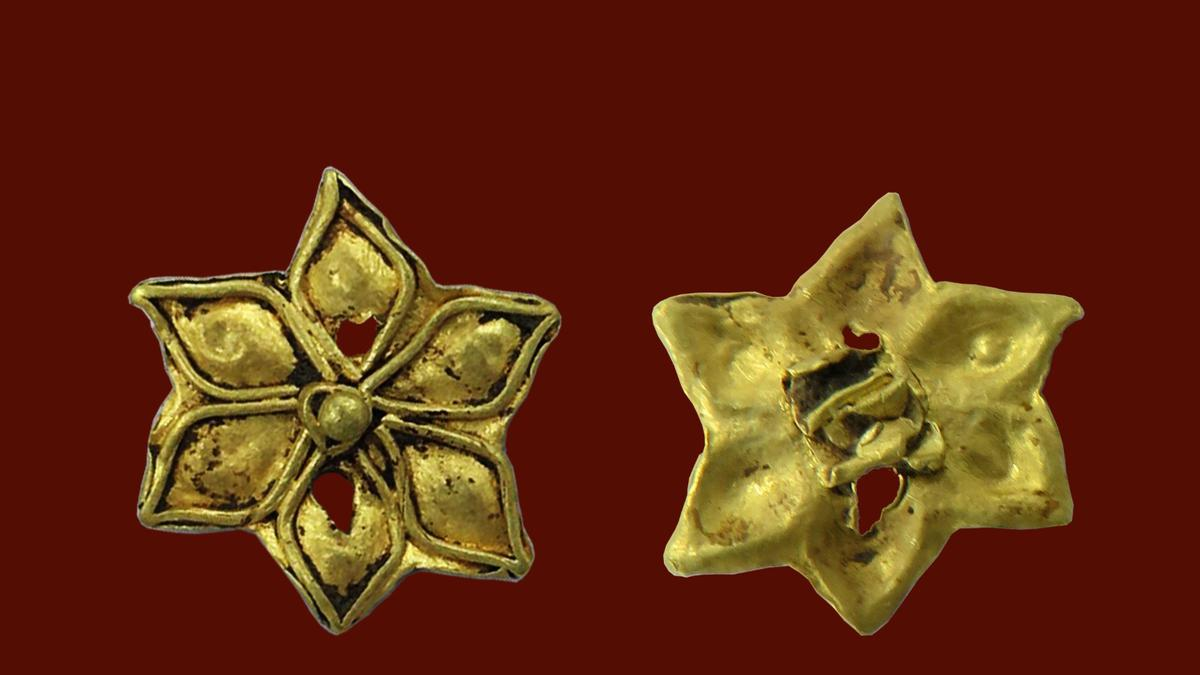 |
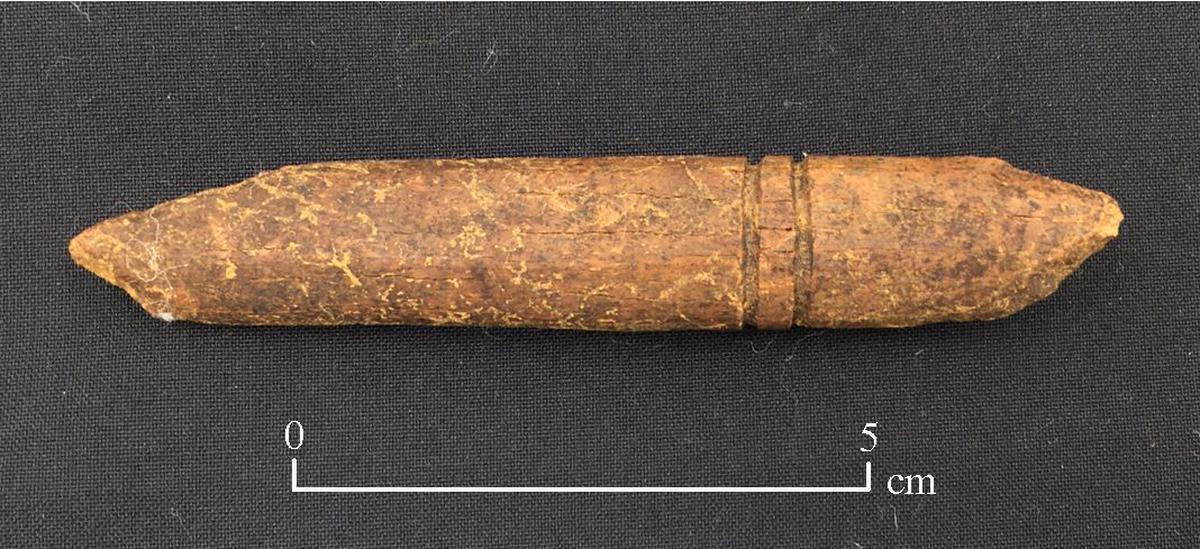 |
 |
Read More: Sangam Age, LiDAR Technology

